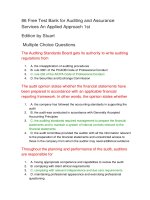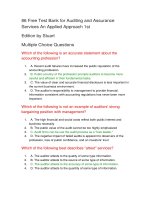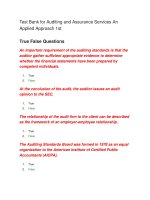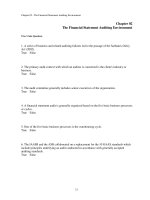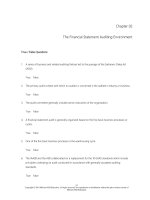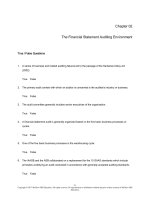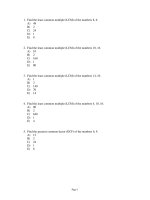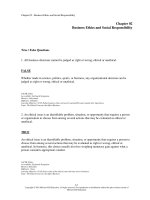Auditing and assurance services a systematic approach 10th edition messier test bank
Bạn đang xem bản rút gọn của tài liệu. Xem và tải ngay bản đầy đủ của tài liệu tại đây (382.3 KB, 54 trang )
Chapter 02
The Financial Statement Auditing Environment
True / False Questions
1.
A series of business and related auditing failures led to the passage of the Sarbanes-Oxley Act
(2002).
True
2.
The primary audit context with which an auditor is concerned is the auditee's industry or business.
True
3.
False
The audit committee generally includes senior executives of the organization.
True
4.
False
False
A financial statement audit is generally organized based on the five basic business processes or
cycles.
True
5.
One of the five basic business processes is the warehousing cycle.
True
6.
False
False
The IAASB and the ASB collaborated on a replacement for the 10 GAAS standards which include
principles underlying an audit conducted in accordance with generally accepted auditing standards.
True
False
2-1
Copyright © 2017 McGraw-Hill Education. All rights reserved. No reproduction or distribution without the prior written consent of McGraw-Hill
Education.
7.
PCAOB auditing standards must be followed on all financial statement audits performed in the U.S.
True
8.
A financial statement audit must be conducted based on GAAP.
True
9.
False
False
Generally, the financial statements of U.S. companies must be prepared based on GAAP.
True
False
10. PCAOB auditing standards must be followed on all audits of public companies' financial statements.
True
False
Multiple Choice Questions
11. The Audit Committee consists of
A. Members of management.
B. A subcommittee of the AICPA who establish the SAS.
C. Members of the Board of Directors.
D. Appointed government overseers.
2-2
Copyright © 2017 McGraw-Hill Education. All rights reserved. No reproduction or distribution without the prior written consent of McGraw-Hill
Education.
12. What organization is responsible for setting auditing standards for audits of publicly-traded
companies in the U.S.?
A. AICPA.
B. FASB.
C. GASB.
D. PCAOB.
13. The Public Company Accounting Oversight Board's role is to
A. Conduct the final review of auditors' work before the auditor's opinion is issued.
B. Oversee the auditors of public companies in order to protect the interests of investors.
C. Conduct audits of governmental entities.
D. Sanction auditors who fail to follow GAAS.
14. The authoritative body designed to promulgate standards concerning a CPA's association with
audited financial statements of an entity that is required to file financial statements with the SEC is
the
A. Financial Accounting Standards Board.
B. General Accounting Office.
C. Public Company Accounting Oversight Board.
D. Auditing Standards Board.
15. The auditor must be independent of the auditee unless
A. The lack of independence does not influence his or her professional judgment.
B. Both parties agree that the independence issue is not a problem.
C. The lack of independence is insignificant.
D. None of the above—the auditor cannot lack independence.
2-3
Copyright © 2017 McGraw-Hill Education. All rights reserved. No reproduction or distribution without the prior written consent of McGraw-Hill
Education.
16. Which of the following describes the PCAOB generally accepted auditing standard requiring a critical
review of the work done and the judgment exercised by those assisting in an audit at every level of
supervision?
A. Proficiency.
B. Audit risk.
C. Inspection.
D. Due care.
17. Which of the following best describes the general character of the three PCAOB generally accepted
auditing standards that are classified as standards of fieldwork?
A. The competence, independence, and professional care of persons performing the audit.
B. Criteria for the content of the auditor's report on financial statements and related footnote
disclosures.
C. The criteria of audit planning and evidence-gathering.
D. The need to maintain independence in mental attitude in all matters relating to the audit.
18. The first PCAOB general standard requires that the examination of financial statements is to be
performed by a person or persons having adequate technical training and
A. Independence with respect to the financial statements and supplementary disclosures.
B. Exercising professional care as judged by peer reviewers.
C. Proficiency as an auditor, which likely has been acquired from previous experience.
D. Objectivity as an auditor as verified by proper supervision.
2-4
Copyright © 2017 McGraw-Hill Education. All rights reserved. No reproduction or distribution without the prior written consent of McGraw-Hill
Education.
19. The first PCAOB standard of reporting requires that, "the report shall state whether the financial
statements are presented in accordance with generally accepted accounting principles." This
passage requires
A. A statement of fact by the auditor.
B. An opinion by the auditor.
C. An implied measure of fairness.
D. An objective measure of compliance.
20. Because of the risk of material misstatement, an audit of financial statements in accordance with
generally accepted auditing standards should be planned and performed with an attitude of
A. Objective cynicism.
B. Independent differentialism.
C. Professional skepticism.
D. Impartial conservatism.
21. The accuracy of information included in footnotes accompanying the audited financial statements
issued by a company whose shares are traded on a stock exchange is the primary responsibility of
A. The stock exchange officials.
B. The independent auditor.
C. The company's management.
D. The Securities and Exchange Commission.
2-5
Copyright © 2017 McGraw-Hill Education. All rights reserved. No reproduction or distribution without the prior written consent of McGraw-Hill
Education.
22. The primary responsibility for the adequacy of disclosures in the financial statements of a publicly
held company rests with the
A. Partner assigned to the audit engagement.
B. Management of the company.
C. Auditor in charge of the fieldwork.
D. Securities and Exchange Commission.
23. The largest public accounting firms typically are structured as
A. Subchapter S corporations.
B. Professional corporations.
C. Limited liability partnerships.
D. Limited liability corporations.
24. Typically, an external auditor first gets supervisory experience at what level of authority?
A. Associate.
B. Senior.
C. Manager.
D. Partner.
25. An "in-charge" auditor typically holds the rank of
A. Associate.
B. Senior.
C. Manager.
D. Partner.
2-6
Copyright © 2017 McGraw-Hill Education. All rights reserved. No reproduction or distribution without the prior written consent of McGraw-Hill
Education.
26. Which of the following best describes the concept of risk assessment on which auditors can provide
independent assurance?
A. The risk that financial statements are misstated because of fraud.
B. The risk that financial statements are misstated because of error or fraud.
C. Whether management has systems in place to evaluate and effectively manage the entity's
business risks.
D. Developing client acceptance and continuance practices that minimize the likelihood of lawsuits
against the auditor.
27. Forensic audits include all of the following except
A. Criminal investigations.
B. Manufacturers' assertions about product quality.
C. Employee fraud.
D. Management fraud.
28. A typical objective of an operational audit is for the auditor to
A. Determine whether the financial statements present fairly the entity's operations.
B. Evaluate the feasibility of attaining the entity's operational objectives.
C. Make recommendations for improving performance.
D. Report on the entity's relative success in attaining profit maximization.
2-7
Copyright © 2017 McGraw-Hill Education. All rights reserved. No reproduction or distribution without the prior written consent of McGraw-Hill
Education.
29. Governmental auditing often extends beyond examinations leading to the expression of an opinion on
the fairness of financial presentation and includes audits of efficiency, effectiveness, and
A. Monetary stimulus.
B. Evaluation.
C. Accuracy.
D. Compliance.
30. External auditors are referred to as "external" because
A. They report to users outside of the audited entity.
B. They are paid by parties outside of the audited entity.
C. They are not employees of the entity being audited.
D. Their offices are not at the entity's place of business.
31. Which is not an attribute of an external auditor?
A. Independence.
B. Auditee advocacy.
C. Objectivity.
D. Concern for the public interest.
32. What is the general character of the work conducted in performing a forensic audit for a company?
A. Providing assurance that the financial statements are not materially misstated.
B. Detecting or deterring fraudulent activity.
C. Offering an opinion on the reliability of the specific assertions made by management.
D. Identifying the causes of an entity's financial difficulties.
2-8
Copyright © 2017 McGraw-Hill Education. All rights reserved. No reproduction or distribution without the prior written consent of McGraw-Hill
Education.
33. Which of the following is NOT a requirement of the Sarbanes-Oxley Act?
A. Audit firms cannot provide most types of nonaudit services to their public company auditees.
B. Audit firms are required to rotate audit partners off audit engagements every five years for public
company audits.
C. Firms that audit public companies are subject to inspection by the PCAOB.
D. A certain number of hours, which is based on the size of the company being audited, must be
spent on each audit engagement.
34. A CPA is most likely to refer to one or more of the three PCAOB general auditing standards in
determining
A. The nature of the CPA's report qualification.
B. The scope of the CPA's auditing procedures.
C. Requirements for the review of the entity and its environment.
D. Whether the CPA should undertake an audit engagement.
35. Who bears ultimate responsibility for the financial statements?
A. Management of the organization, equally with the external auditor that audits the statements.
B. Management and the shareholders of the organization.
C. The external auditor that audits the statements.
D. Management of the organization.
2-9
Copyright © 2017 McGraw-Hill Education. All rights reserved. No reproduction or distribution without the prior written consent of McGraw-Hill
Education.
36. The three PCAOB general standards are concerned with
A. Adequate training and proficiency of the auditor, proper planning and supervision, and due
professional care.
B. Adequate training and independence.
C. Due professional care.
D. Independence, adequate training and due professional care.
37. The first PCAOB general standard recognizes that regardless of how capable an individual may be in
other fields, the individual cannot meet the requirements of the auditing standards without the proper
A. Business and finance courses.
B. Quality control and peer review.
C. Education and experience in auditing.
D. Supervision and review skills.
38. The main difference between SAS and AU is
A. They are the same except that SAS are organized chronologically and the AU are organized by
topical area.
B. SAS are issued by the ASB and AU are issued by the PCAOB.
C. SAS are issued by the PCAOB and AU are issued by the ASB.
D. SAS define minimum standards of performance for auditors while AU define financial accounting
principles that must be followed according to GAAP.
2-10
Copyright © 2017 McGraw-Hill Education. All rights reserved. No reproduction or distribution without the prior written consent of McGraw-Hill
Education.
39. The AICPA's Statements on Auditing Standards can be described as
A. Providing very specific guidance about the specific activities an auditor must perform on each
engagement.
B. Similar to financial accounting standards in that they are developed by the government.
C. Defining the minimum standards of performance for an auditor.
D. Providing assurance that an auditor will not issue an incorrect opinion.
40. Due professional care requires auditors to
A. Obtain independent, third party (non-auditee) documentation as evidence for all information
presented in the financial statements.
B. Exercise professional skepticism during the audit.
C. Disregard any evidence generated by the auditee during the audit.
D. Find every error contained in the financial statements prepared by management.
41. The objective of the second PCAOB Standard of Reporting is to provide assurance that
A. There are no variations in the format and presentation of financial statements.
B. Substantially different transactions and events are not accounted for on an identical basis.
C. The auditor is consulted before material changes are made in the application of accounting
principles.
D. The comparability of financial statements between periods is not materially affected by changes in
accounting principles that are not disclosed.
2-11
Copyright © 2017 McGraw-Hill Education. All rights reserved. No reproduction or distribution without the prior written consent of McGraw-Hill
Education.
42. An internal auditor is likely to be more concerned with _________________ than the external auditor.
A. Internal administrative procedures
B. Cost accounting procedures
C. The efficiency of operations
D. Internal control
43. Which of the following is not included in the broad category of assurance services?
A. Operational audit.
B. Reporting on internal control.
C. Accounting or review services.
D. Evaluation of the auditee's risk management framework.
44. Which of the following is not explicitly a part of the IIA's definition of internal auditing?
A. Internal auditing is an objective assurance activity.
B. Internal auditing is a consulting activity.
C. Internal auditing should help an organization accomplish its objectives.
D. Internal auditors should help external auditors complete the annual financial statement audit.
45. Which of the following statements regarding the PCAOB is incorrect?
A. It is a public-sector, nonprofit corporation.
B. It is overseen by the SEC.
C. It sets standards for public company audits.
D. It has delegated all of its standard-setting authority to the AICPA.
2-12
Copyright © 2017 McGraw-Hill Education. All rights reserved. No reproduction or distribution without the prior written consent of McGraw-Hill
Education.
46. Due professional care requires
A. Auditors to plan and perform their duties with the skill and care that is commonly expected of
accounting professionals.
B. The examination of all available corroborating evidence.
C. The exercise of error-free judgment.
D. A study and review of internal controls that includes tests of controls.
47. Which of the following best describes the role of corporate governance?
A. Management decides which accounting principles are the most appropriate.
B. Shareholders vote to decide who should be members of the board of directors.
C. Holding the management team accountable to shareholders and other constituents for the
utilization of the entity's resources.
D. Management often is compensated based on the company's profitability.
48. The four PCAOB standards of reporting are concerned with all of the following except
A. The presentation of the financial statements based on GAAS.
B. The presentation of the financial statements based on GAAP.
C. Whether principles are consistently applied, whether all informative disclosures have been made,
and the degree of responsibility the auditor is taking.
D. The degree of responsibility the auditor is taking.
49. Which of the following best describes what is meant by generally accepted auditing standards?
A. Audit assertions generally determined on audit engagements.
B. Acts to be performed by the auditor.
C. Standards of quality for the auditor's performance.
D. Procedures to be used to gather evidence to support financial statements.
2-13
Copyright © 2017 McGraw-Hill Education. All rights reserved. No reproduction or distribution without the prior written consent of McGraw-Hill
Education.
50. The fourth PCAOB standard of reporting requires an auditor to render a report whenever an auditor's
name is associated with financial statements. The overall purpose of the fourth standard of reporting
is to require that reports
A. State that the examination of financial statements has been conducted in accordance with
generally accepted auditing standards.
B. Indicate the character of the auditor's examination and the degree of responsibility assumed by the
auditor.
C. Imply that the auditor is independent in fact as well as in appearance with respect to the financial
statements under examination.
D. Express whether the accounting principles used in preparing the financial statements have been
applied consistently in the period under examination.
51. The three PCAOB standards of fieldwork are concerned with
A. Planning and supervision and understanding the auditee's internal control system.
B. Choosing evidence with due professional care.
C. Adequate training to understand the auditee's internal controls system.
D. Ensuring consistency in financial statements for periods presented.
52. The fourth PCAOB reporting standard requires the auditor's report to contain either an expression of
opinion regarding the financial statements taken as a whole or an assertion to the effect that an
opinion cannot be expressed. The objective of the fourth standard is to prevent
A. An auditor from reporting on one basic financial statement and not the others.
B. An auditor from expressing different opinions on each of the basic financial statements.
C. Management from reducing its final responsibility for the basic financial statements.
D. Misinterpretations regarding the degree of responsibility the auditor is assuming.
2-14
Copyright © 2017 McGraw-Hill Education. All rights reserved. No reproduction or distribution without the prior written consent of McGraw-Hill
Education.
Short Answer Questions
53. The IAASB and the ASB have collaborated on the principles underlying an audit conducted in
accordance with generally accepted auditing standards. These principles are grouped into four
categories. What are the four categories?
54. The principles underlying an audit conducted in accordance with generally accepted auditing
standards are grouped into four categories. The second category is that of "personal responsibility of
the auditor." Generally explain what is intended by this principle.
2-15
Copyright © 2017 McGraw-Hill Education. All rights reserved. No reproduction or distribution without the prior written consent of McGraw-Hill
Education.
55. You are the owner of a small grocery store, Corner Marketplace. Explain the five process categories
and how they apply to your business.
56. Define corporate governance, the board of directors, and the audit committee and explain how they
relate to each other.
57. Describe the organizations involved in standard setting for auditors in the United States and what
their respective roles are in setting current auditing standards for companies in the United States.
2-16
Copyright © 2017 McGraw-Hill Education. All rights reserved. No reproduction or distribution without the prior written consent of McGraw-Hill
Education.
58. What are the three PCAOB general auditing standards found within the 10 GAAS (NOT the three
main categories of GAAS) and why is each important?
59. Jane Goodperson performed an audit on the Quagmire Corporation and issued an unqualified
opinion. Jane performed the audit with due professional care and in accordance with generally
accepted auditing standards. Two months after the report is issued, Jane discovers on the news that
the CEO of Quagmire, Johnny Best, had been stealing small amounts of inventory. The amount,
however, is immaterial compared to the overall inventory of the corporation. Jane soon receives a call
from Quagmire's CFO, Mark Beastly. Mark wants Jane to refund her audit fees. Mark thinks Jane did
not properly perform the audit, as she did not discover this fraud. Further, he feels that now
Quagmire's financial statements are not fairly stated because of Jane. How should Jane respond to
this claim?
2-17
Copyright © 2017 McGraw-Hill Education. All rights reserved. No reproduction or distribution without the prior written consent of McGraw-Hill
Education.
60. Mike has just graduated from State University with a bachelor's degree in accounting. He would like
to pursue a career in auditing. What options does Mike have? Describe three auditing career options,
including a description of the organization Mike would work for.
61. With respect to an entity's financial statements, describe both the responsibility of management and
that of the auditor.
2-18
Copyright © 2017 McGraw-Hill Education. All rights reserved. No reproduction or distribution without the prior written consent of McGraw-Hill
Education.
62. What auditing standards are used to conduct an audit for a privately-held corporation? What auditing
standards are used to conduct an audit for a publicly-traded corporation? What organization is
responsible for setting each of these sets of standards?
63. There are several types of audit services that are provided by auditors. Identify and define three of
these types of audits.
2-19
Copyright © 2017 McGraw-Hill Education. All rights reserved. No reproduction or distribution without the prior written consent of McGraw-Hill
Education.
Chapter 02 The Financial Statement Auditing Environment Answer Key
True / False Questions
1.
A series of business and related auditing failures led to the passage of the Sarbanes-Oxley Act
(2002).
TRUE
AACSB: Communication
AICPA: BB Legal
AICPA: FN Measurement
Accessibility: Keyboard Navigation
Blooms: Remember
Difficulty: 1 Easy
Learning Objective: 02-04 Understand the significant changes that have taken place in the auditing profession over the past decade.
Topic: A Decade of Challenge and Change for Financial Statement Auditors
2.
The primary audit context with which an auditor is concerned is the auditee's industry or business.
TRUE
AACSB: Communication
AICPA: BB Industry
AICPA: FN Decision Making
Accessibility: Keyboard Navigation
Blooms: Remember
Difficulty: 1 Easy
Learning Objective: 02-06 Recognize that an audit is shaped by the auditee's business; industry; and economic environment; and
understand the essential components and processes characteristic of most business entities.
Topic: A Model of Business
3.
The audit committee generally includes senior executives of the organization.
FALSE
AACSB: Communication
AICPA: BB Industry
2-20
Copyright © 2017 McGraw-Hill Education. All rights reserved. No reproduction or distribution without the prior written consent of McGraw-Hill
Education.
AICPA: FN Reporting
Accessibility: Keyboard Navigation
Blooms: Remember
Difficulty: 1 Easy
Learning Objective: 02-06 Recognize that an audit is shaped by the auditee's business; industry; and economic environment; and
understand the essential components and processes characteristic of most business entities.
Topic: A Model of Business
4.
A financial statement audit is generally organized based on the five basic business processes or
cycles.
TRUE
AACSB: Communication
AICPA: BB Industry
AICPA: FN Decision Making
Accessibility: Keyboard Navigation
Blooms: Remember
Difficulty: 1 Easy
Learning Objective: 02-07 Be familiar with a five-component model of business processes used to organize an audit.
Topic: A Model of Business
5.
One of the five basic business processes is the warehousing cycle.
FALSE
AACSB: Communication
AICPA: BB Industry
AICPA: FN Decision Making
Accessibility: Keyboard Navigation
Blooms: Remember
Difficulty: 1 Easy
Learning Objective: 02-07 Be familiar with a five-component model of business processes used to organize an audit.
Topic: A Model of Business
6.
The IAASB and the ASB collaborated on a replacement for the 10 GAAS standards which include
principles underlying an audit conducted in accordance with generally accepted auditing
standards.
TRUE
AACSB: Communication
2-21
Copyright © 2017 McGraw-Hill Education. All rights reserved. No reproduction or distribution without the prior written consent of McGraw-Hill
Education.
AICPA: BB Legal
AICPA: FN Reporting
Accessibility: Keyboard Navigation
Blooms: Remember
Difficulty: 1 Easy
Learning Objective: 02-09 Understand that auditing standards are established by both U.S. and international standard setters.
Learning Objective: 02-10 Be familiar with the 10 "generally accepted auditing standards" and the "principles underlying an audit
conducted in accordance with generally accepted auditing standards."
Topic: Auditing Standards
7.
PCAOB auditing standards must be followed on all financial statement audits performed in the
U.S.
FALSE
AACSB: Communication
AICPA: BB Legal
AICPA: FN Reporting
Accessibility: Keyboard Navigation
Blooms: Understand
Difficulty: 1 Easy
Learning Objective: 02-08 Identify and be familiar with the major organizations that affect the public accounting profession's
environment.
Topic: A Model of Business
8.
A financial statement audit must be conducted based on GAAP.
FALSE
AACSB: Communication
AICPA: BB Legal
AICPA: FN Reporting
Accessibility: Keyboard Navigation
Blooms: Understand
Difficulty: 1 Easy
Learning Objective: 02-09 Understand that auditing standards are established by both U.S. and international standard setters.
Learning Objective: 02-10 Be familiar with the 10 "generally accepted auditing standards" and the "principles underlying an audit
conducted in accordance with generally accepted auditing standards."
Topic: Auditing Standards
2-22
Copyright © 2017 McGraw-Hill Education. All rights reserved. No reproduction or distribution without the prior written consent of McGraw-Hill
Education.
61.
With respect to an entity's financial statements, describe both the responsibility of management
and that of the auditor.
The financial statements are the responsibility of management. The auditor's responsibility is to
express an opinion on the financial statements based on the audit.
AACSB: Communication
AICPA: BB Critical Thinking
AICPA: FN Decision Making
Blooms: Understand
Difficulty: 1 Easy
Learning Objective: 02-05 Know that management is primarily responsible for the entity's financial statements and understand the
auditor's responsibility for detecting errors; material fraud; and illegal acts.
Topic: Society's Expectations and the Auditor's Responsibilities
62.
What auditing standards are used to conduct an audit for a privately-held corporation? What
auditing standards are used to conduct an audit for a publicly-traded corporation? What
organization is responsible for setting each of these sets of standards?
Auditing standards developed by the AICPA's Auditing Standards Board (ASB) are used to
conduct an audit for a privately-held corporation or other entities that are nonpublic companies.
This includes the principles underlying an audit conducted in accordance with generally accepted
auditing standards and the ASB's Statements on Auditing Standards (SAS).
Auditing standards developed by the Public Company Accounting Oversight Board (PCAOB) must
be used to conduct an audit for a publicly-traded corporation. These standards include all those
issued by the ASB through 2003, which were codified by the PCAOB, and any new standards
issued by the PCAOB after that point.
AACSB: Communication
AICPA: BB Legal
AICPA: FN Reporting
Blooms: Remember
Difficulty: 2 Medium
Learning Objective: 02-09 Understand that auditing standards are established by both U.S. and international standard setters.
Learning Objective: 02-10 Be familiar with the 10 "generally accepted auditing standards" and the "principles underlying an audit
2-53
Copyright © 2017 McGraw-Hill Education. All rights reserved. No reproduction or distribution without the prior written consent of McGraw-Hill
Education.
conducted in accordance with generally accepted auditing standards."
Topic: Auditing Standards
63.
There are several types of audit services that are provided by auditors. Identify and define three of
these types of audits.
Answer should include any three of the following:
Financial Statement Audit: Auditors test the transactions, balances, and disclosures in a set of
financial statements to determine if they are materially correct.
Internal Control Audit: Auditors test the internal controls of a company to determine whether the
control system is functioning effectively (i.e. preventing, or detecting and correcting,
misstatements in the financial statements).
Compliance Audit: Auditors test the extent to which rules, policies, laws, covenants, or
government regulations are followed by the entity.
Operational Audit: Auditors review part or all of an organization's activities to evaluate whether
resources are being used effectively and efficiently. The auditor assesses the entity's
performance, identifies areas for improvement, and develops recommendations.
Forensic Audit: Auditors conduct forensic audits to detect or deter fraudulent activities.
AACSB: Communication
AICPA: BB Industry
AICPA: FN Reporting
Blooms: Remember
Difficulty: 2 Medium
Learning Objective: 02-02 Be familiar with the various types of audit; attest; and assurance services offered by accounting
professionals.
Topic: Types of Other Audit, Attest, and Assurance Services
2-54
Copyright © 2017 McGraw-Hill Education. All rights reserved. No reproduction or distribution without the prior written consent of McGraw-Hill
Education.
